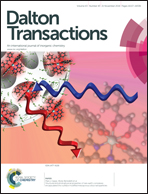A calix[2]triazole[2]arene-based fluorescent chemosensor for probing the copper trafficking pathway in Wilson's disease†
Abstract
A pyrenyl-appended calix[2]triazole[2]arene displaying excellent selectivity for Cu2+ over other metal ions in pyrenyl excimer emission changes was synthesized. The binding mode with Cu2+ was supported through nuclear magnetic resonance (NMR) studies and density functional theory (DFT) calculations. Fluorescence imaging demonstrates that this new copper sensor is capable of detecting intracellular copper in living cells. Furthermore, through colocalization of the probe with organelle trackers as a function of time, it was observed that copper initially accumulates in lysosomes and then decreases. These results provide evidence for a close relationship between copper and lysosomes in Wilson's disease. This system is the first Cu2+ ion-induced fluorescent turn-on system used for imaging copper trafficking over time in a Wilson's disease model.
![Graphical abstract: A calix[2]triazole[2]arene-based fluorescent chemosensor for probing the copper trafficking pathway in Wilson's disease](/en/Image/Get?imageInfo.ImageType=GA&imageInfo.ImageIdentifier.ManuscriptID=C4DT02208D&imageInfo.ImageIdentifier.Year=2014)

 Please wait while we load your content...
Please wait while we load your content...